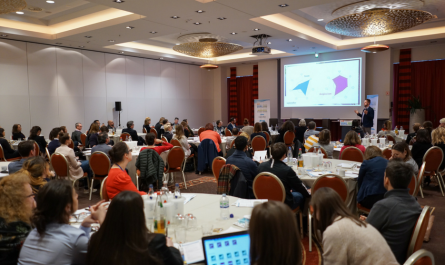The heroic journey of sustainability executives and investors – and what it means for your organization
This white paper summarizes the results from qualitative research that was part of a collaboration between the Zicklin Center for Business Ethics Research at Wharton School, University of Pennsylvania and Olson Zaltman, covering a range of sustainability, leadership, and innovation issues.
The Challenge: Corporations face increasing pressure to address sustainability, most recently framed around ESG (environmental, social, and governance) issues.
However, organizational leaders may not be fully aware of the emotional challenges and obstacles ESG executives are facing and the “unwritten rules” of their organizational culture that discourage holistic ESG engagement.
The Research: We interviewed ESG executives and investors around the world using the Zaltman Metaphor Elicitation Technique (ZMET), which provides insights into people’s unconscious beliefs, biases, and motivations. All respondents were asked to collect a set of symbolic images that represented their thoughts and feelings about “ESG issues and their role in your business.”
The Results: Based on the metaphoric imagery and language from the ZMET interviews, we use the term ESG Ecosystem Journey to provide a better understanding of (1) the role of ESG leaders and (2) the dynamic of ESG ecosystem changes. These insights can help ESG leaders engage with multiple stakeholders more productively, and can also help organizational leaders understand the unspoken barriers to ESG implementation inside their organizations.
ESG is an Ecosystem within a System
To more insightfully capture the important role of the human dimension in developing ESG-informed strategies, it is important to look at an organization through the lens of complex living systems – the critical move from system to ecosystem thinking. The use of the ESG ecosystem lens increases awareness of the importance of the interdependences, not just the interconnections.
“It really comes back to realizing that we’re all interdependent. No one is ever just an investor. Investors are also employees, they’re also customers, and everyone is, of course, a member of our planet.”
Moreover, executives and investors understand that the ecosystem is constantly evolving, which requires ongoing learning and adaptation.
“I don’t think there is an end of the bridge because we are, as human beings, always evolving and developing. There will be new challenges, new issues that will come in.”
Furthermore, the ecosystem is still highly inefficient. ESG standards are confusing. Indeed, there is no shared understanding or even definition of ESG, which can make it difficult for executives to muster internal support for sustainability initiatives.
“All these rating agencies and systems and standards and I am trying to dive in, swim, and make sense of it. What’s important? What’s not? Our CEO is like, you should come to the executive committee and present all these acronyms so we can understand what is happening.”
BRINGING ORDER TO THE CHAOTIC ESG ECOSYSTEM
The Hero’s Journey is a narrative pattern first described by Joseph Campbell in his 1949 book, The Hero with a Thousand Faces. Myths, novels, movies, and stories of all kinds frequently follow the Hero’s Journey template.
The Hero’s Journey consists of three parts – what Campbell called the departure, the initiation, and the return. Let’s use The Wizard of Oz to illustrate these three phases.
- The Departure. In this phase, the hero yearns for more, but struggles to leave behind the comfortable ordinary world. In The Wizard of Oz, Dorothy feels secure but somewhat constrained by her ordinary life in Kansas until a tornado sweeps her away into an enchanted land.
- The Initiation. In this phase, the Hero encounters various challenges and allies in the quest toward some goal. Dorothy proceeds down the Yellow Brick Road with assistance from The Tin Man, The Cowardly Lion, and The Scarecrow. Eventually, they achieve their goal of meeting The Wizard.
- The Return. Here the Hero returns to the ordinary world with newfound strength and wisdom. Dorothy awakens from her “dream” back on the farm in Kansas with a fresh appreciation of her life.
Our ZMET research reveals ESG investors and executives unconsciously use the same Hero’s Journey framework when thinking about their own professional experiences navigating the world of sustainability and promoting the importance of ESG principles inside their organizations.
ACT 1 – THE DEPARTURE
The way these organizational leaders were selected signals the relevance of the ESG issues from the C-level perspective.
- Some executives and investors were asked to lead because of their experience.
- Others were asked to lead because of their values and passion.
- Still others volunteered to lead because of their values and passion.
The selection clearly indicates that the human dimension driving selection is key element of how the journey starts. Values, passion, and individual purpose dominate the story of selection and to some extent the experience throughout the journey.
ACT 2 – THE INITIATION
Especially during the early steps along the journey – but also at certain points along the way – executives and investors are plagued with feelings of isolation and inadequacy, a sense that they are misunderstood, and a nagging concern that their efforts ultimately will be in vain.
In order to overcome these challenges and create new opportunities, leaders need resources and support from various levels within their organizations. These resources include:
- Speedy, actionable learning
- Internal coalitions
- Freedom to innovate
- Authority to implement their ideas
- Trust
“Some people are now waking up. I have meetings and calls with my CFO – two years ago [he] didn’t even know what ESG standards were. The conversations would be almost zero. It was almost philanthropic. Before, it was hard to be relevant. Now, I have more impact and influence. You feel you are in the right place because sustainability is taken seriously.”
As these leaders head toward their destination, they accumulate small wins, each of which make ESG seem more “real” and help to build credibility with stakeholders inside and outside their organizations.

“A lot of our workers have to cross the border, but when we were in lockdown the border was closed. When the customs officers heard we were doing so much for the hospitals, we got special treatment and people could go to work. People would stop us at the border saying, ‘You’re the company doing all the great stuff. Thank you so much!’
“This image symbolizes how that uplifted people and made them feel proud to be a part of the company. When people start to support you or management gets behind things, it is very powerful. It creates a super-positive dynamic for everybody. It is great satisfaction. It makes your job tangible.”
Ultimately, these leaders are motivated to go on despite the challenges because success is a matter of “life or death” for their organizations – and for society.
“If you’re not incorporating [ESG], not taking it seriously, if you’re not knowledgeable about it, if you’re not leveraging it, then you’re not going to survive in the industry. The hand is all the people of earth and the future that we have in our hands. We can do something today so that we can still have a planet to live on. It is pressure, it is urgency.”
ACT 3 – THE RETURN
In this case, the return hasn’t occurred yet – these executives are still in the midst of their ESG journey. However, despite the challenges and moments of despair, their overall outlook is optimistic and they are confident they will look back on their careers secure that they made a difference.

“This represents hope that things are going in the right direction. The concrete represents the status quo. But this flower is punching through and making companies change their structure and the way they look at the future. Will it take 50 years? 100 years? Who knows? But hopefully this represents accelerating awareness and changing behavior.”
IS YOUR ORGANIZATION READY?
The insights from the ESG Ecosystem Journey provide a comprehensive understanding of the hidden biases and behaviors and emotions dimensions of personal journey of sustainability executives and investors.
ESG challenges require truly innovative solutions, not just fine-tuning current products and services or offering slight tweaks to business models. These resulting opportunities can include (but are not limited to):
- Productively shaping the external business and policy ecosystem
- Entering new markets
- Innovative alliances with non-traditional partners, including competitors
- Access to actionable knowledge and new forms of capital, not limited to financial capital
An organization’s culture – the often unspoken and unconscious values and assumptions that govern behavior – can either facilitate this kind of innovative thinking or constrain it. Understanding the emotional journey of sustainability leaders inside your organization will reveal their emotional needs and the aspects of the culture that may be inhibiting them – insights that are critical for advancing any company’s ESG agenda.
Editor’s Note: Learn more about this study in-person at QUAL360 Europe on 8-9 February in Berlin. Visit event website for more info: https://eu.qual360.com/










 by
by 

